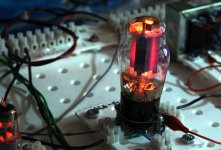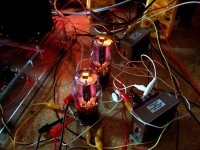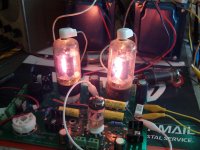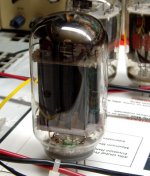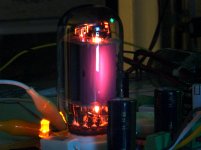It looks like you wired the resistors in parallel, not in series. The effective resistance in parallel would be around 118 ohms. 20 volts at 118 ohms would be 169 mA per tube. You may have blown the output tubes.
Good deal my tubes are still fine. I was wondering why they seemed to really be getting hot quick. I'll wait for my correct resistors to arrive and wire them in. I'm sure those tubes lost a few hours of listening time! I can't believe I didn't realize how i was wiring those up....after all I am an industrial electrician! I'm just glad I wasn't at work and made a mistake like this, I'd never live it down. I haven't dealt with series and parallel circuits since school. I'm usually just given a schematic and wire it up, Or babysit my machines and replace a prox!
Last edited:
Good deal my tubes are still fine. I was wondering why they seemed to really be getting hot quick ...
That was about 64 watts / 6L6GC, before they went into runaway and blew the fuse, so, once you get your amp squared away, I would put fresh tubes in it, and save these 6L6GC for testing or emergency spares.
When the tubes get really hot, like these must have, they can outgas impurities and reduce the vacuum in the tube, which makes it more likely they can overheat and runaway again, unpredictably, so, as cheap as new production tubes are, I just would not trust them. If they runaway and the fuse does not blow, a transformer could get damaged. Generally when a transformer is damaged, you throw it away and buy another. It looks like you have expensive transformers in your amp ...
You also put about 360 ma through your rectifier tube before the power tubes went into runaway and blew the fuse. It was also grossly overloaded, so I would put in a fresh rectifier tube as well; you can keep the present tube as an emergency spare.
You should never see red in any metal part of a tube, except for the heater and cathode, which will usually be a dull orange in receiving tubes. If you do see red, turn the amp off immediately - something is wrong. There are some transmitting tubes where red is okay, but you won't be using those in an SSE.
None of us are born knowing this stuff, we all have to learn it somehow or sometime. That's what makes the sub forum such a valuable resource.
That was about 64 watts / 6L6GC, before they went into runaway and blew the fuse, so, once you get your amp squared away, I would put fresh tubes in it, and save these 6L6GC for testing or emergency spares.
When the tubes get really hot, like these must have, they can outgas impurities and reduce the vacuum in the tube, which makes it more likely they can overheat and runaway again, unpredictably, so, as cheap as new production tubes are, I just would not trust them. If they runaway and the fuse does not blow, a transformer could get damaged. Generally when a transformer is damaged, you throw it away and buy another. It looks like you have expensive transformers in your amp ...
You also put about 360 ma through your rectifier tube before the power tubes went into runaway and blew the fuse. It was also grossly overloaded, so I would put in a fresh rectifier tube as well; you can keep the present tube as an emergency spare.
You should never see red in any metal part of a tube, except for the heater and cathode, which will usually be a dull orange in receiving tubes. If you do see red, turn the amp off immediately - something is wrong. There are some transmitting tubes where red is okay, but you won't be using those in an SSE.
None of us are born knowing this stuff, we all have to learn it somehow or sometime. That's what makes the sub forum such a valuable resource.
Thanks for the detailed reply. I was figuring the tubes were pretty much shot even if they worked. I have a spare rectifier tube but I'll get some more 6L6 tubes on the way and let the amp sit until all my right stuff gets here. This forum has been a great resource for me. This is my first amp build, first tube amp, so I was expecting a bit of a learning curve. I'm just glad I didn't fry anything, glad the fuse blew first!
A bit painful to be "watching" you go through this, brother. Really sorry to hear about what happened.
It is a learning curve for sure. I hope to avoid such mistakes, but I have recently learned that I can't trust myself to always be sharp.
I guess with high voltage stuff, everything is fine as long as it didn't kill you.
It is a learning curve for sure. I hope to avoid such mistakes, but I have recently learned that I can't trust myself to always be sharp.
I guess with high voltage stuff, everything is fine as long as it didn't kill you.
A bit painful to be "watching" you go through this, brother. Really sorry to hear about what happened.
It is a learning curve for sure. I hope to avoid such mistakes, but I have recently learned that I can't trust myself to always be sharp.
I guess with high voltage stuff, everything is fine as long as it didn't kill you.
Hey all is good! My amp still works, tubes can be used as test tubes from here on out. All of this was self inflicted on my part by not following the checkout process as one should and not properly reading the data sheets for my tubes. As long as someone else can gain from my mistakes and not repeat them I am happy.
I am just glad there is such a great resource for help here!
I hope you have better luck!
Just got my shipment in from Digikey with the new 680ohm 5 watt resistors and binding posts. Also installed new tubes and my current inrush limiter, no blown fuses so far!
No red plating! I am now down to right at 25watts dissipated
Thanks again for all the help!
Great news, man! Glad to hear you got it all figured out.
I have owned these cheap Chinese 6L6GC's since I pulled them out of a Fender Bandmaster because the amps owner wanted new tubes. This was at least 20 years ago.
I use them any time I want to try something where the tube may not live. Oddly enough they are BOTH still working, but one does work a little better than the other.
They have been into the red zone too many times to remember.....
The 6BQ6GA's that I pushed past red, past orange, and into white hot, are still technically working, but have some distortion issues.....I probably rearranged the molecular structure of some of their inner guts.
While working on a little SPUD amp I found a 21LR6 tube that had a crack in the glass running up the entire side of the tube. I figured that it would be gassy, or shatter when powered up, so I almost tossed it....Then I decided that I would at least blow it up before trashing it. So I cranked it well into the red zone and waited for something bad to happen.....nothing just good sounding music. After about an hour of running in the red, I decided to save it. That was 10 years ago and it still works.
Sometimes our old tubes will take a beating and ask for more, other times they just blow up for no reason.
I use them any time I want to try something where the tube may not live. Oddly enough they are BOTH still working, but one does work a little better than the other.
They have been into the red zone too many times to remember.....
The 6BQ6GA's that I pushed past red, past orange, and into white hot, are still technically working, but have some distortion issues.....I probably rearranged the molecular structure of some of their inner guts.
While working on a little SPUD amp I found a 21LR6 tube that had a crack in the glass running up the entire side of the tube. I figured that it would be gassy, or shatter when powered up, so I almost tossed it....Then I decided that I would at least blow it up before trashing it. So I cranked it well into the red zone and waited for something bad to happen.....nothing just good sounding music. After about an hour of running in the red, I decided to save it. That was 10 years ago and it still works.
Sometimes our old tubes will take a beating and ask for more, other times they just blow up for no reason.
Attachments
- Status
- This old topic is closed. If you want to reopen this topic, contact a moderator using the "Report Post" button.
- Home
- More Vendors...
- Tubelab
- SSE Checkout
